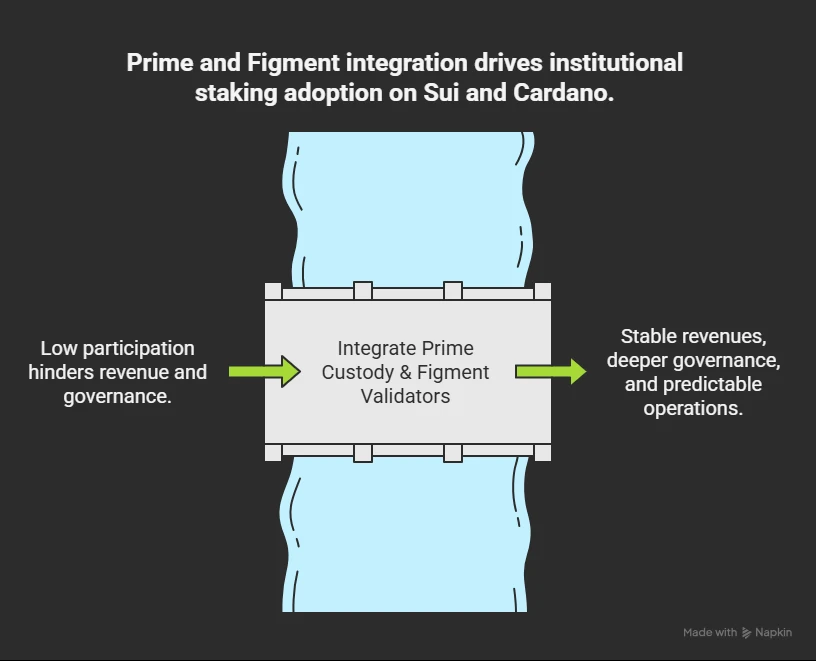Coinbase and Figment Bring Institutional Staking to Sui and Cardano, Over $2 Billion Staked

Coinbase Prime and Figment expanded their staking integration to a broader set of proof-of-stake networks, placing Sui and Cardano near the top of the list. Institutions can now delegate directly from Prime custody while using Figment’s validators, keeping audit trails and reward reporting in one place. The collaboration has already crossed $2 billion in staked capital, signaling real institutional demand.
- Sui and Cardano Headline a Broader Rollout
- How the Integration Works Inside Prime Custody
- Why it Matters for Order Flow, Risk, and Reporting
- Market and Investor Lens: What to Track Next
- Quick Comparison Table
- Conclusion
- Frequently Asked Questions About Coinbase and Figment Bring Institutional Staking to Sui and Cardano
- How do institutions stake SUI and ADA through Prime?
- Which networks are covered beyond Sui and Cardano?
- What is the scale of the Coinbase–Figment relationship today?
- Why mention Delegated Proof of Stake in this context?
- Does this change price dynamics for SUI or ADA?
The update matters for asset managers that hold SUI and ADA under qualified custody but have avoided operational sprawl. A custody-native flow reduces fund movements, centralizes permissions, and standardizes risk checks. Sui and Cardano, both built around Delegated Proof of Stake (DPoS), slot neatly into this model, allowing large holders to participate in consensus while preserving policy controls and clean oversight.
Sui and Cardano Headline a Broader Rollout
The Block first highlighted that Prime’s integration with Figment now spans a growing roster, including Solana, Sui, Aleo, Aptos, Avalanche, Axelar, Cardano, Celestia, Cosmos, EigenLayer, NEAR, and Polkadot. For Sui and Cardano allocators, the key change is simple: staking moves from a fragmented, multi-vendor setup into one custody-first workflow with unified reporting and validator selection.
Business Wire’s release underscored scale. Figment cited over $18 billion under stake across its platform and more than $2 billion staked through the Prime integration alone. That history matters because institutions value continuity of service, documented controls, and slashing risk management. A seasoned operator base lowers perceived operational risk for SUI and ADA positions inside complex mandates.
Blockworks added context on timing and scope, confirming the expansion and the $2 billion threshold. The announcement lands as regulated wrappers with on-chain yield features gain traction, aligning institutional processes with protocol rewards. Sui and Cardano benefit from that alignment because both rely on holder delegation to professional validators, a pattern that is easier to scale when custody and staking sit together.
Figment’s own note connected the integration to recent market structure milestones, pointing to prior collaboration on the first U.S. ETH ETP with staking. That linkage reinforces a trend toward compliant yield capture inside regulated channels. For Sui and Cardano, the narrative is not about branding. It is about turning governance and security participation into an auditable policy action.
How the Integration Works Inside Prime Custody
Institutions keep SUI and ADA in Coinbase Prime custody, then delegate to Figment-run validators through the Prime interface. Rewards, performance metrics, and activity logs flow back into a consolidated dashboard that investment, operations, and audit teams already use for execution and financing. The setup preserves segregation of duties while removing manual reconciliations across vendors.
Coinbase Prime and Figment expand institutional staking to Solana, Cardano, Sui and other networks https://t.co/c63GRgU4XR
— The Block (@TheBlock__) October 28, 2025
This custody-native route addresses several frictions. It reduces asset transfers, limits key management complexity, and supports policy-based approvals for staking actions. For Sui and Cardano, where Delegated Proof of Stake expects broad participation, the move lets institutional holders contribute to network security without building validator teams or adding non-standard tooling to their stacks.
ALSO READ: Cardano Hits Record 115M Transactions, Celebrates 8 Years of Steady Uptime, Usage
The partner roles are clear. Coinbase Prime provides qualified custody, permissions, and an enterprise console. Figment provides validator infrastructure, performance tuning, and slashing risk frameworks. Together, they allow large holders to size positions, rotate validators, and document outcomes. That clarity can matter more than a few basis points of reward variance for auditors and risk committees.
Coverage across outlets converges on the same operational details, which reduces announcement noise. Institutions stake assets from Prime custody, keep controls in place, and rely on Figment’s validator coverage across networks. This is a design pattern, not a one-off integration. It brings Sui and Cardano into a shared institutional muscle memory already familiar from Ethereum flows.
Why it Matters for Order Flow, Risk, and Reporting
Sui and Cardano rely on healthy delegation and validator diversity. By making delegation a button inside custody, the expansion can raise the percentage of stake that institutions commit, supporting node economics and network security. It does not set a price. It standardizes how large holders participate in protocol rewards without diluting oversight.
Risk teams gain from fewer handoffs. A single console handles whitelists, approvals, and record-keeping. Validator performance and slashing protection sit behind a provider with scale. For SUI and ADA, that combo reduces perceived tail risks tied to operational error. It also strengthens internal narratives around governance participation as a documented, recurring policy action.
The timing intersects with a broader theme. Several outlets note that yield-enabled ETFs and ETPs are moving from theory to practice. When wrappers, custody, and validator access align, allocators can propose staking not as an exotic workflow, but as an extension of existing controls. That framing benefits Delegated Proof of Stake (DPoS) networks seeking durable, policy-driven participation.
ALSO READ: 21Shares Amends Sui Staking ETF for Nasdaq, Market Responds with a 2.5% Surge
Competition among validators will likely intensify. With custody-native discovery and standardized reporting, institutions can rotate toward operators with better performance or risk profiles. That dynamic may push transparency forward on metrics that matter: uptime, missed slots, and realized reward rates. Sui and Cardano communities have long argued for this discipline. The integration could harden it at scale.
Figment and Coinbase broaden staking access to networks beyond Ethereum pic.twitter.com/nA2IexUT7t
— Blockworks (@Blockworks_) October 28, 2025
Market and Investor Lens: What to Track Next
First, watch delegation percentages on Sui and Cardano as custodial platforms promote one-seat staking. Even modest increases in institutional participation can stabilize validator revenues and deepen governance engagement. These are structural effects, not trade signals. They can, however, influence how treasuries and funds size exposures through platforms they already use.
Second, monitor how many networks join the Prime–Figment roster, since relative yields and validator capacity can shift allocator attention. The list is already broad, ranging from Solana and Avalanche to Cosmos and NEAR, with Celestia and EigenLayer in the mix. A multi-chain menu reduces single-network concentration risk and encourages disciplined, cross-chain policy reviews.
Third, note references to this integration inside fund documents or compliance updates. If staking-enabled products and separate accounts cite Prime custody plus Figment validators, the model is becoming a default. That would reinforce the role of qualified custody in Delegated Proof of Stake participation for Sui and Cardano without forcing bespoke infrastructure investments.

Finally, watch the communication cadence from both companies. Business Wire, Figment’s newsroom, and trade coverage from Blockworks and The Block are reading from the same script on scope and controls. Consistent messaging suggests the rollout is staged and repeatable, not experimental, which matters for institutions seeking predictable operations on SUI and ADA.
Quick Comparison Table
| Item | Sui | Cardano |
| Staking model | Holder delegation to validators (DPoS) | Holder delegation to stake pools (DPoS-style) |
| Prime integration | Delegate from custody to Figment validators | Delegate from custody to Figment validators |
| Institutional hook | Unified custody, reporting, and rewards | Mature delegation culture with pool metrics |
Conclusion
Coinbase Prime and Figment moved institutional staking from a patchwork into a single, custody-first workflow and added Sui and Cardano to the center of it. The model keeps assets in Prime, routes delegation to Figment, and standardizes controls and reporting. For Delegate Proof of Stake or DPoS networks that want broad, policy-driven participation, this is the practical path to scale.
The rollout lands as yield-enabled products evolve and validator competition sharpens. Institutions gain fewer handoffs, clearer audit trails, and a repeatable process for on-chain rewards. Sui and Cardano gain a cleaner route to durable delegation. The story is not about speculation. It is about market plumbing catching up to how modern DPoS networks actually work.
Frequently Asked Questions About Coinbase and Figment Bring Institutional Staking to Sui and Cardano
How do institutions stake SUI and ADA through Prime?
Assets remain in Prime custody. Delegation to Figment validators happens inside the Prime console. Rewards and logs feed back into Prime reporting, which supports approvals, whitelists, and audits for investment and operations teams. The goal is standardization, not reinvention of the toolchain.
Which networks are covered beyond Sui and Cardano?
The current roster includes Solana, Sui, Aleo, Aptos, Avalanche, Axelar, Cardano, Celestia, Cosmos, EigenLayer, NEAR, and Polkadot, with more to come as the integration matures. Coverage is expanding gradually as validator capacity and custody controls align.
What is the scale of the Coinbase–Figment relationship today?
The partners report more than $2 billion staked through the integration, with Figment citing over $18 billion under stake across its broader platform. The relationship began with Ethereum in early 2024 and has widened into a multi-chain model.
Why mention Delegated Proof of Stake in this context?
Sui and Cardano rely on holder delegation to professional validators or pools. A custody-native delegation path inside Prime helps institutions meet policy requirements while contributing to network security and governance, which strengthens DPoS network health without forcing operational sprawl.
Does this change price dynamics for SUI or ADA?
No direct price claims follow from an operational integration. The development can influence validator economics, delegation rates, and governance participation. Those factors support network resilience but do not guarantee market outcomes. Investors should treat the change as process infrastructure, not a catalyst.




